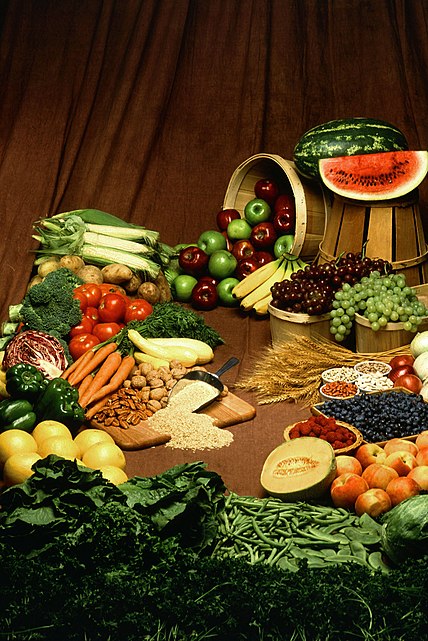A vitamin is an organic compound required as a nutrient in tiny amounts by an organism. A compound is called a vitamin when it cannot be synthesized in sufficient quantities by an organism, and must be obtained from the diet. Thus, the term is conditional both on the circumstances and the particular organism. For example, ascorbic acid functions as vitamin C for some animals but not others, and vitamins D and K are required in the human diet only in certain circumstances.
Vitamins are classified by their biological and chemical activity, not their structure. Thus, each "vitamin" may refer to several vitamer compounds that all show the biological activity associated with a particular vitamin. Such a set of chemicals are grouped under an alphabetized vitamin "generic descriptor" title, such as "vitamin A," which includes the compounds retinal, retinol, and many carotenoids. Vitamers are often inter-converted in the body. The term vitamin does not include other essential nutrients such as dietary minerals, essential fatty acids, or essential amino acids, nor does it encompass the large number of other nutrients that promote health but are otherwise required less often.
Vitamins have diverse biochemical functions, including function as hormones (e.g. vitamin D), antioxidants (e.g. vitamin E), and mediators of cell signaling and regulators of cell and tissue growth and differentiation (e.g. vitamin A). The largest number of vitamins (e.g. B complex vitamins) function as precursors for enzyme cofactor bio-molecules (coenzymes), that help act as catalysts and substrates in metabolism. When acting as part of a catalyst, vitamins are bound to enzymes and are called prosthetic groups. For example, biotin is part of enzymes involved in making fatty acids. Vitamins also act as coenzymes to carry chemical groups between enzymes. For example, folic acid carries various forms of carbon group – methyl, formyl and methylene - in the cell. Although these roles in assisting enzyme reactions are vitamins' best-known function, the other vitamin functions are equally important.
Until the 1900s, vitamins were obtained solely through food intake, and changes in diet (which, for example, could occur during a particular growing season) can alter the types and amounts of vitamins ingested. Vitamins have been produced as commodity chemicals and made widely available as inexpensive pills for several decades, allowing supplementation of the dietary intake.
| The discovery of vitamins and their sources | ||
| Vitamin | Source | |
| Vitamin A (Retinol) | Cod liver oil | |
| Vitamin B1 (Thiamin) | Rice bran | |
| Vitamin C (Ascorbic acid) | Lemons | |
| Vitamin D (Calciferol) | Cod liver oil | |
| Vitamin B2 (Riboflavin) | Eggs | |
| Vitamin E (Tocopherol) | Wheat germ oil, Cosmetic and Liver | |
| Vitamin B12 (Cyanocobalamin) | Liver | |
| Vitamin K (Phylloquinone) | Alfalfa | |
| Vitamin B5 (Pantothenic acid) | Liver | |
| Vitamin B7 (Biotin) | Liver | |
| Vitamin B6 (Pyridoxine) | Rice bran | |
| Vitamin B3 (Niacin) | Liver | |
| Vitamin B9 (Folic acid) | Liver | |

